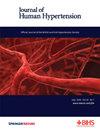纤维蛋白原对耐药性高血压患者预后的影响。
IF 2.7
4区 医学
Q2 PERIPHERAL VASCULAR DISEASE
引用次数: 0
摘要
在这项研究中,我们探讨了纤维蛋白原水平对抵抗性高血压患者长期预后的影响。研究回顾性地纳入了266名具有血清纤维蛋白原测量结果和5年随访资料的抵抗性高血压患者。根据患者的纤维蛋白原水平对其进行分层,然后将其分为三等分。在5年后对主要不良心血管事件(MACE)的临床结果进行评估。MACE定义为全因死亡率、心血管死亡率、非致死性心肌梗死(MI)、非致死性中风、心力衰竭新诊断或因心力衰竭和外周动脉疾病住院。抵抗性高血压患者5年后MACE的发生率在纤维蛋白原最高的三分位数中更高。多变量分析发现,纤维蛋白原是耐药高血压患者MACE的独立预测因子(几率比=1.002;95% CI:1.001-1.004;P=0.009)。与最低三分位数相比,第二分位数的 MACE 高出约 2.5 倍,最高三分位数的 MACE 高出约 6.9 倍。纤维蛋白原能够预测抵抗性高血压患者的 MACE(MACE 的 AUC 为 0.662(95% CI 0.596-0.727; p本文章由计算机程序翻译,如有差异,请以英文原文为准。

Prognostic impact of fibrinogen in patients with resistant hypertension
In this study, we investigated the long-term prognostic effects of fibrinogen levels in patients with resistant hypertension. A total of 266 patients with resistant hypertension who had serum fibrinogen measurements and 5 years of follow-up information were retrospectively included in the study. The patients were stratified according to their fibrinogen levels, which were then divided into tertiles. Clinical outcomes for major adverse cardiovascular events (MACE) were assessed at 5 years. MACE was defined as all-cause mortality, cardiovascular mortality, non-fatal myocardial infarction (MI), non-fatal stroke, a new diagnosis of heart failure, or hospitalization for heart failure and peripheral arterial disease. The incidence of MACE at 5 years in patients with resistant hypertension was higher in the highest tertile of fibrinogen. Multivariate analysis identified fibrinogen as an independent predictor of MACE in patients with resistant hypertension (odds ratio = 1.002; 95% CI: 1.001–1.004; p = 0.009). Compared to the lowest tertile, MACE was approximately 2.5 times higher in tertile 2 and approximately 6.9 times higher in the highest tertile. Fibrinogen was able to predict MACE in patients with resistant hypertension (AUC for MACE 0.662 (95% CI 0.596–0.727; p < 0.001) based on receiver operating characteristic curve analysis. In the Kaplan–Meier curve showing follow-up without MACE (MACE-free) according to the fibrinogen cut-off value, the 5-year incidence of MACE was significantly higher in the high fibrinogen group (p < 0.001). Fibrinogen is a risk marker for MACE in patients with resistant hypertension. Antihypertensive therapy aimed at lowering fibrinogen levels may improve prognosis.
求助全文
通过发布文献求助,成功后即可免费获取论文全文。
去求助
来源期刊

Journal of Human Hypertension
医学-外周血管病
CiteScore
5.20
自引率
3.70%
发文量
126
审稿时长
6-12 weeks
期刊介绍:
Journal of Human Hypertension is published monthly and is of interest to health care professionals who deal with hypertension (specialists, internists, primary care physicians) and public health workers. We believe that our patients benefit from robust scientific data that are based on well conducted clinical trials. We also believe that basic sciences are the foundations on which we build our knowledge of clinical conditions and their management. Towards this end, although we are primarily a clinical based journal, we also welcome suitable basic sciences studies that promote our understanding of human hypertension.
The journal aims to perform the dual role of increasing knowledge in the field of high blood pressure as well as improving the standard of care of patients. The editors will consider for publication all suitable papers dealing directly or indirectly with clinical aspects of hypertension, including but not limited to epidemiology, pathophysiology, therapeutics and basic sciences involving human subjects or tissues. We also consider papers from all specialties such as ophthalmology, cardiology, nephrology, obstetrics and stroke medicine that deal with the various aspects of hypertension and its complications.
 求助内容:
求助内容: 应助结果提醒方式:
应助结果提醒方式:


